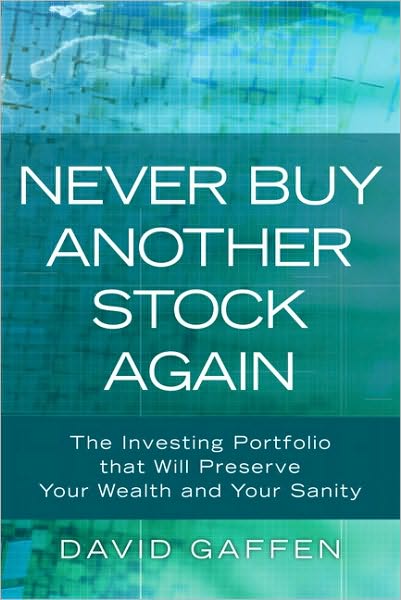Responding to a Bright Reader
One of my readers made some good comments, and asked some good questions, so I am responding here.? From the article, Dave, What Should I Do? (3):
DM: Some of my friends want to invest with me, but I am not a total solution to anyone?s financial needs, because the only stuff I am managing is the risk capital.
Reader: Just curious, why did you choose to go this route instead of the “total solution” route.
Later in this post, you have very detailed bond fund recommendations, so why not just manage the total portfolio with the appropriate asset allocation across risk capital versus bonds?
I’m not seeing the advantage of just the risk capital approach. It seems like less AUM, and less fees, and the client still has to figure out what to do with the remainder of the investable capital.
Between your comments, and requests from clients and potential clients, that is what led me to start the fixed income strategy.? I am moving some of my family’s assets into that strategy so that I have “skin in the game.”? I always thought I would do this, but I thought it would come later.? Reality has intervened.
And, from the article, Managing Fixed Income for Equity Clients:
Given your background, I would think managing the bond portion would be almost a triviality. I would assume for bigger accounts you could do individual bonds effectively, and I understand for smaller accounts going the CEF/ETF route. I am genuinely curious why for smaller accounts you would totally avoid actively managed bond funds. This is what I currently do. I use Hussman Total Return and PIMCO Total Return for my bond allocation, but I have been thinking about further diversifying that. I?ve been thinking of adding Jeff Gundlach?s new fund now that he is on his own. My understanding is he is considered one of the top bond fund managers. I?ve also heard Dan Fuss from Loomis Sayles is really good. My thought with the bond allocation is to put it on auto-pilot as much as possible, and focus my efforts on generating alpha in the risk asset part of the portfolio.On a broader point, I think you are right about offering this, because I think most people are looking for a ?total solutions? provider. If one only manages the equity allocation, then I think you almost have to stress that to the client, and then they are still left to their own devices on what to do with the rest of the investable money. My thought is why give up that business and more importantly are you really helping that person by basically saying I only do A and you are on your own for the rest. In my view, managing the total portfolio is really win-win for both the advisor and client, and I am actually surprised at the number of advisors who only do stock-picking. My thought is they largely only do that because that is what they like.
Anyways, I hope this has been somewhat helpful, and I?d love your feedback on some of the funds I mentioned if you care to offer it.
I have respect for Dan Fuss, Jeff Gundlach, John Hussman, Vanguard and Pimco.? Pimco is misunderstood, because it is a quant shop, and uses a ton of fixed income derivatives.? Vanguard has the most durable advantage because of low expenses.
Why am I not using actively managed bond funds?? I would rather work with simple vehicles that allow me to express my macro views, and have low costs for clients.? I am the manager.? If I use actively managed funds, I am the manager of managers.? That is not what I want to be.? Eventually, if my fixed income assets get big enough, I will stop using funds and buy bonds directly.? And that will be a lot of fun, because when I managed a lot of bond assets, I was able to add a lot of value through clever trading.
And from the article Abandon All Hope All Ye Who Enter Here:
1.? What do you mean by “dual currency”?
2.? In your view, what are the investment/portfolio implications of what appears to be the inevitability of nothing meaningful getting done on fiscal policy until the crisis hits with full force.? Seems to me many, even highly intelligent people, believe we can put off adjustments for another day down the road.
http://oldprof.typepad.com/a_dash_of_insight/2011/03/constructive-postponement.html
Dual currency means that a nation has two currencies, one for domestic dealings, and one for international dealings.? I do not advocate it, but such a system can be used to favor domestic interests over international interests, or vice-versa.? It depends what the government wants to do.? Historically, there have been cases where a government under stress:
- defaults on foreign obligations
- defaults on domestic obligations
- defaults on both
The dual currency helps with the first two options, because it allows the government to easily choose who to pay.
On the fiscal policy deadlock: the credit cycle is unpredictable in term of detailed timing.? How much more the credit cycle as applied to governments, which “never go broke.”? Things are great until they aren’t.? Who predicted that the PIIGS would erupt specifically in 2010?? Seeing the troubles is easy, naming the time is tough.
Delay merely makes the future solutions tougher, because the problem to solve is bigger.? The trouble is, we don’t know what actions our government will take.? I lean toward inflation, given the tendency of American history, but who can tell?
This is a tough time to be managing bonds, but what time isn’t?



